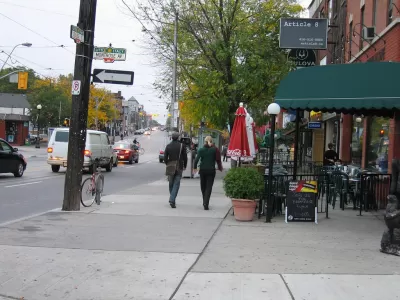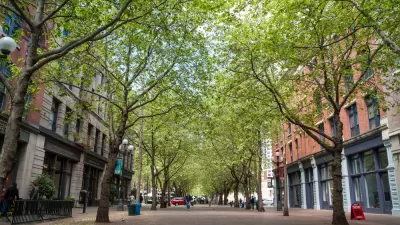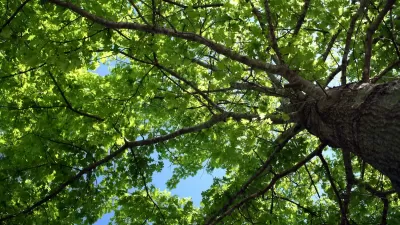Researchers at the University of New Mexico created a sidewalk design using materials that would reduce heat absorption and require fewer materials than traditional concrete sidewalks.

Traditional concrete sidewalks "absorb heat, occasionally buckling because of the pressure from heated expansion; and can even reflect heat, causing 'heat islands' in urban areas." Hope Muñoz and Rachel Whitt report on an innovation that could replace concrete with cooler, more environmentally friendly materials. Research students at the University of New Mexico have "designed a sidewalk built using recycled and less energy- and carbon-intensive materials," which is also much thinner than the average four-inch sidewalk.
After looking at historic sidewalk construction, researcher Patience Raby said "[i]t seems there was not good explanation for the use of standard concrete mixes in sidewalks or even for the fact that they’re usually four inches deep." According to a Federal Highway Administration report, "Atmospheric heat islands can affect communities by increasing summertime peak energy demand, electrical grid reliability, air conditioning costs, air pollution and GHG emissions, heat-related illness and death, and water quality." The new design reduces heat and the amount of materials needed for its construction. "The researchers fabricated three slabs to compare their thermal output, emissivity, and energy balance."
"In the future, the team would like to design 3D printed concrete slabs and those which are thin fiber reinforced with voids. These slabs would later be tested for heat storage potential."
FULL STORY: UNM researchers explore cool and renewable sidewalks

Study: Maui’s Plan to Convert Vacation Rentals to Long-Term Housing Could Cause Nearly $1 Billion Economic Loss
The plan would reduce visitor accommodation by 25,% resulting in 1,900 jobs lost.

North Texas Transit Leaders Tout Benefits of TOD for Growing Region
At a summit focused on transit-oriented development, policymakers discussed how North Texas’ expanded light rail system can serve as a tool for economic growth.

Why Should We Subsidize Public Transportation?
Many public transit agencies face financial stress due to rising costs, declining fare revenue, and declining subsidies. Transit advocates must provide a strong business case for increasing public transit funding.

How to Make US Trains Faster
Changes to boarding platforms and a switch to electric trains could improve U.S. passenger rail service without the added cost of high-speed rail.

Columbia’s Revitalized ‘Loop’ Is a Hub for Local Entrepreneurs
A focus on small businesses is helping a commercial corridor in Columbia, Missouri thrive.

Invasive Insect Threatens Minnesota’s Ash Forests
The Emerald Ash Borer is a rapidly spreading invasive pest threatening Minnesota’s ash trees, and homeowners are encouraged to plant diverse replacement species, avoid moving ash firewood, and monitor for signs of infestation.
Urban Design for Planners 1: Software Tools
This six-course series explores essential urban design concepts using open source software and equips planners with the tools they need to participate fully in the urban design process.
Planning for Universal Design
Learn the tools for implementing Universal Design in planning regulations.
Ascent Environmental
Borough of Carlisle
Institute for Housing and Urban Development Studies (IHS)
City of Grandview
Harvard GSD Executive Education
Toledo-Lucas County Plan Commissions
Salt Lake City
NYU Wagner Graduate School of Public Service





























